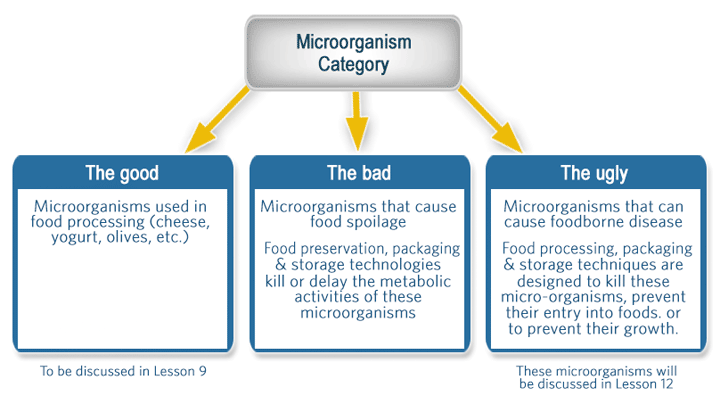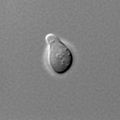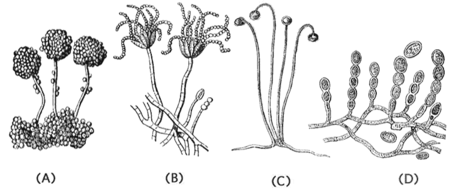Course:FNH200/Lessons/Lesson 05/Page 05.2
5.2 Microorganisms
- Microorganisms are ubiquitous. Almost all food materials that arrive at food processing plants, retail stores, food service receiving docks, and even your kitchen, are contaminated with a variety of microorganisms.
- Microorganisms cause a great deal of food spoilage throughout the world. This has major economic consequences and also result in loss of potential sources of nutrients, since the spoiled food typically is discarded.
| Want to learn more? |
|
Microorganisms can be classified into 3 general categories as shown in Figure 5.2.
From Fig 5.2., we note that microorganisms can be put to good use for the production of fermented foods, but that they can also be the causes of spoilage and food borne diseases. Bacteria, yeasts and moulds may contribute to production of fermented foods, as well as food spoilage and food borne disease. Viruses although not considered true microorganism they can be agents of food borne disease but do not cause food spoilage, nor are they used to produce fermented foods.
In this lesson, we will focus primarily on obtaining a general understanding of the role of microorganisms in the deterioration or spoilage of food. The importance of microorganisms in fermented foods and food borne diseases will be discussed in more depth in Lessons 9 and 12, respectively.
Some important characteristics of microorganisms in foods causing food spoilage are summarized below:
Bacteria
Bacteria are the microorganisms that grow the fastest in food.
They reproduce by cell division, whereby one cell divides into two, and these two daughter cells further each divide into another two cells.
The time taken for bacterial cells to complete one complete cycle of cell division is the generation time. With a generation time of 7 minutes, a single bacterial cell could produce a population of a billion cells within 210 minutes (3 1/2 hours).
Bacteria may exist in two forms:
vegetative cells, which are actively metabolizing cells, consume nutrients and produce waste products.
spores, which are the dormant form of the bacterial cell. The spore is analogous to the seed of a green plant. All of the genetic material is contained within the spore. When favourable conditions are encountered, the spore germinates and produces an actively metabolizing bacterial cell capable of cell division).
Yeasts
Yeasts are commonly found in many foods of agricultural and aquatic origin. Yeasts reproduce by budding.
They generally grow more slowly than bacteria but can tolerate more severe environmental conditions than bacteria.
- For example yeasts are not inhibited by pH to the same extent as bacteria
- Yeasts can grow in many foods with low water activity that would normally inhibit growth of bacteria
Some yeasts are used to produce fermented foods and beverages.
Moulds
Moulds are filamentous and are also found on most foods of agricultural and aquatic origin. Most moulds produce spores.
Like yeasts, moulds can grow on foods that have a low pH and also in foods with low water activities that would inhibit growth of bacteria and yeasts.
Some moulds are used in the production of mould-fermented foods (e.g. mould ripened cheeses), but most moulds are agents of food spoilage and many also produce toxins (mycotoxins) under favourable conditions.
What are microbial spores?
- Mold and some bacteria produce spores. Microbial spores are very resistant to a variety of conditions (heat, dehydration, ionizing radiation, antimicrobial agents) that can inhibit or cause death of the vegetative cell.
- In food preservation and processing, the spores of Clostridium botulinum, an anaerobic bacterium, are of great concern because the spores are very heat resistant. Clostridium botulinum is also the group of bacteria that produces the toxin that causes the very serious illness, botulism. We will discuss Clostridium botulinum in more detail in Lessons 6 and 12
Oxygen and temperature requirements for microorganisms:
Microorganisms can also be characterized on the basis of temperature ranges and oxygen requirements over which growth occurs. For example, mould are strictly aerobic (require oxygen), but different mould species can have different temperature requirements. Some bacteria are aerobic mesophiles, and some are anaerobic mesophiles.
Oxygen requirements:
- AEROBICgrow only in the presence of dissolved oxygen (Bacteria, yeast, mould)
- ANAEROBICgrow only in the absence of dissolved oxygen (Bacteria)
- FACULTATIVE ANAEROBEcan grow in the presence or absence of oxygen (Bacteria, yeast)
| Temperature requirements | ||
|---|---|---|
| Classification | Growth temperatures (°C) | Characteristics |
| Psychrophiles
Psychrotrophs |
0 to 18
-5 to 35 |
Psychrophiles grow well in cold temperatures, while Psychrotrophs have adapted to living and multiplying in cold environments. Psychrotrophs are the major cause of spoilage in refrigerated foods. |
| Mesophiles | 10 to 45 | Mesophiles grow well in moderate temperatures. Many mesophiles have an optimum growth temperature of 37°C. Most spoilage and disease-causing organisms are mesophiles. |
| Thermophiles | 50 to >100 | Thermophiles grow best at high temperatures. Most thermophilic organisms are spoilage-causing. |




